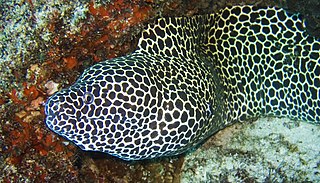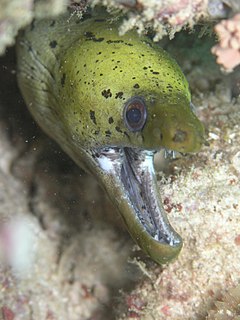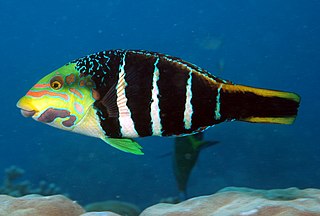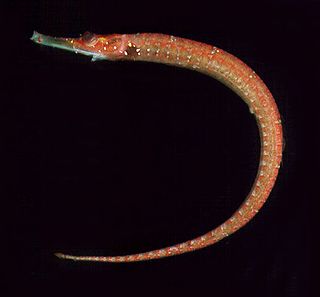
The laced moray, also known as the leopard moray, leopard moray eel, tessellate moray or honeycomb moray, is a species of marine fish in the family Muraenidae.

The pennant coralfish, also known as the longfin bannerfish, reef bannerfish or coachman, is a species of fish of the family Chaetodontidae, native to the Indo-Pacific area.

The zebra moray, Gymnomuraena zebra, is a species of marine fish in the family Muraenidae. It is the only member of the genus Gymnomuraena, though it sometimes has been included in Echidna instead.

The fimbriated moray, also known as dark-spotted moray or spot-face moray, is a moray eel of the family Muraenidae.

The pyramid butterflyfish is a species of marine ray-finned fish, a butterflyfish belonging to the family Chaetodontidae, native from central Indo-Pacific.

Gymnothorax nudivomer, the starry moray or yellowmouth moray, is a species of marine fish in the family Muraenidae.

The bird wrasse, Gomphosus varius, is a species of the wrasse family.

Corythoichthys intestinalis, known commonly as the scribbled pipefish, is a species of marine fish in the family Syngnathidae. Other common names used include banded pipefish, Australian banded pipefish, Australian messmate pipefish and messmate pipefish.

The whitemargin moray or the white-edged moray, Gymnothorax albimarginatus, is a species of marine fish in the family Muraenidae.

The blackcheek moray eel or masked moray is a species of marine fish in the family Muraenidae.

The barred-fin moray or bar-tail moray is a species of marine fish in the family Muraenidae.

The barred thicklip wrasse, Hemigymnus fasciatus, is a species of fish belonging to the wrasse family, native from the Indo-Pacific.

Corythoichthys nigripectus is a species of marine fish of the family Syngnathidae. It is found in the Indo-Pacific, from the Red Sea, Indonesia and the Philippines to the Society Islands, Guam and New Caledonia. It inhabits coral reefs and algae patches at depths of 5–30 metres (16–98 ft), where it can grow to lengths of 11 centimetres (4.3 in). This species is both monogamous and ovoviviparous, with males carrying eggs and giving birth to live young.

Cosmocampus banneri is a species of marine fish of the family Syngnathidae. It is found from the Red Sea and Western Indian Ocean to Fiji, the Marshall Islands, and the Ryukyu Islands. It lives in coral reefs at depths of 2-30m, where it can grow to lengths of 5.8 cm. Although little is known about the feeding habits of C. banneri, it is expected to feed on small crustaceans similar to other pipefish. This species is ovoviviparous, with males carrying eggs in a brood pouch until giving birth to live young. The specific name honours Albert Henry Banner (1914-1985), an American carcinologist who was an expert in alpheid shrimps.
Cosmocampus darrosanus is a species of marine fish of the family Syngnathidae. It is found in the Western Indian Ocean, Sri Lanka, Indonesia, Guam, and the Great Barrier Reef (Australia). It lives in tidepools and coral reefs to depths of 3 metres (9.8 ft), where it can grow to lengths of 7.4 centimetres (2.9 in). This species is ovoviviparous, with males carrying eggs before giving birth to live young. The specific name is taken from the type locality of D'Arros Island in the Amirante Islands.

Cosmocampus maxweberi is a species of marine fish of the family Syngnathidae. It is found in the Red Sea from Sumatra to Tonga and Samoa, and from the Marshall Islands to the Great Barrier Reef. Adults live in reefs and reef-rubble to depths of 36 m, while planktonic juveniles have been found in the top 85m of 1500–2000 m water columns. Adults are expected to feed on small crustaceans, similar to other pipefish, and can grow to lengths of 10 cm. This species is ovoviviparous, with males carrying eggs until giving birth to live young. The specific name honours the German-Dutch zoologist and biogeographer Max Carl Wilhelm Weber (1852-1937).

Doryrhamphus negrosensis, commonly known as Negros pipefish, flagtail pipefish, Masthead Island pipefish or Queensland flagtail pipefish, is a species of marine fish of the family Syngnathidae. It is found in the Western Pacific Ocean, from Borneo to Vanuatu and the Yaeyama Islands to the Rowley Shoals and the Great Barrier Reef. It lives in mud flats and reefs, both coral and rocky, where it is often associated with sea urchins. It is a rather solitary species which may be found in pairs or small groups. It inhabits depths to 9 metres (30 ft), and can grow to lengths of 6.2 centimetres (2.4 in). Although little is known of its feeding habits, it is expected to feed on harpacticoid copepods, gammarid shrimps, and mysids, similar to other pipefish, it may also act as a cleaner fish like other species in the genus Doryrhamphus. This species is ovoviviparous, with males carrying eggs before giving birth to live young. Males may brood at 4.3 cm. It is a small bluish to bluish-grey pipefish which has a pale stripe along the dorsal side of the head and snout, and a dark fan-like caudal fin which has white margins and an orange base.

Halicampus brocki, the tasselled pipefish, or Brock's pipefish, is a species of marine fish of the family Syngnathidae. It is found in the Indo-Pacific, from southern Japan, Guam and the Marshall Islands to the central east and west coasts of Australia. It lives on coral and rocky reefs with algae, to depths of 45 metres (148 ft). It can grow to lengths of 12 centimetres (4.7 in), and is expected to feed on small crustaceans, similar to other pipefish. This species is ovoviviparous, with males carrying eggs and giving birth to live young.

The Samoan pipefish, or brown pipefish, is a species of marine fish of the family Syngnathidae. It is found in the Indo-Pacific, from the Red Sea, to Sodwana Bay, to Taiwan, the Marshall Islands, and Samoa, where it inhabits tidepools and coral and rocky reefs to depths of 15 metres (49 ft). It is a solitary species with cryptic habits and is rarely observed. It is likely to feed on small crustaceans, and can grow to lengths of 14 centimetres (5.5 in). This species is ovoviviparous, with males carrying the fertilised eggs in a brood pouch, the folds of which fall well short of the centre of the egg-filled pouch, eventually giving birth to live young. The specific name honours Mataafa, a former king of Samoa. It is a listed marine species under the Australian Environment Protection and Biodiversity Conservation Act 1999.
The glittering pipefish is a species of marine coastal fish of the family Syngnathidae. It is found in the Western Pacific, from Viet Nam to Fiji and from the Ryukyu Islands to New Caledonia, where it inhabits corals, sand and reef flats to depths of 20 metres (66 ft).< It can grow to lengths of 7.3 centimetres (2.9 in), and is expected to feed on small crustaceans, similar to other pipefishes. It is secretive and rarely observed. This species is ovoviviparous, with males carrying eggs and giving birth to live young.




















